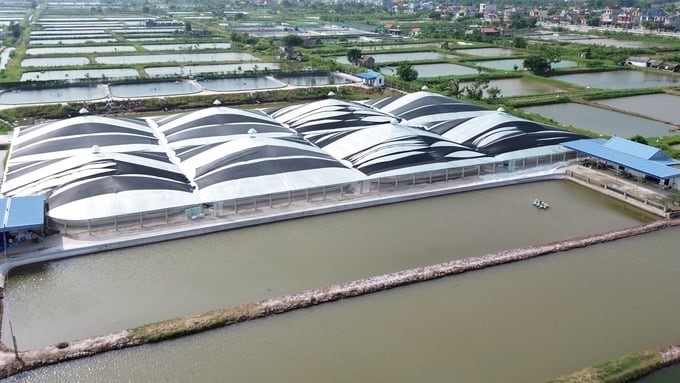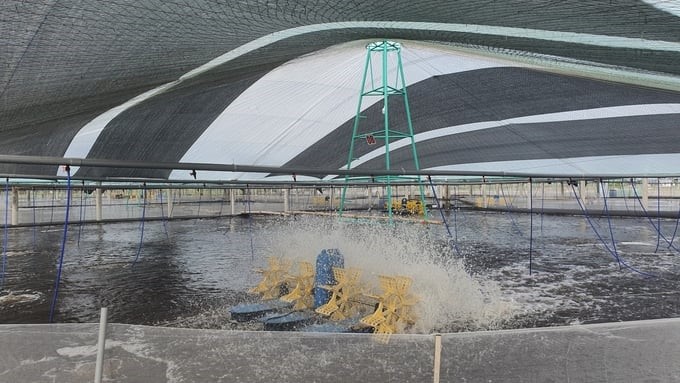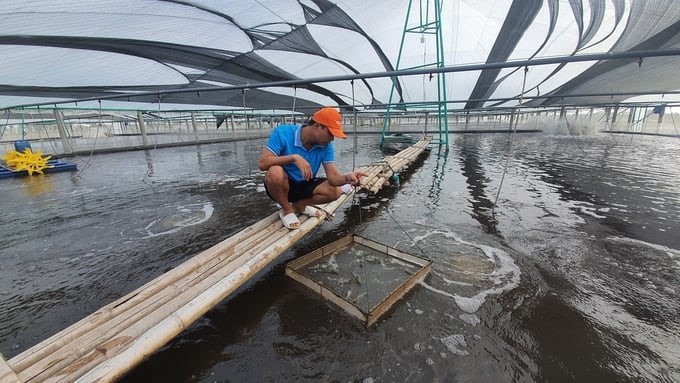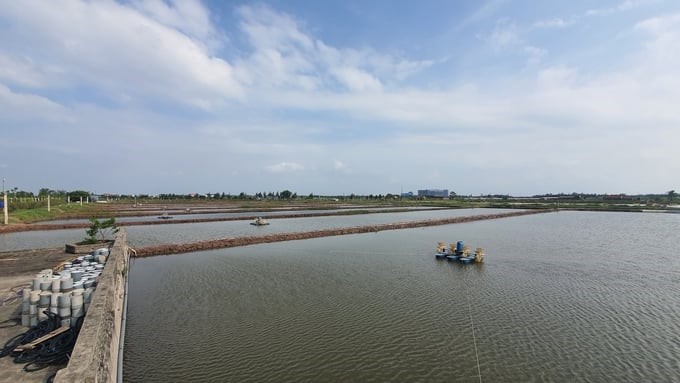May 29, 2025 | 16:20 GMT +7
May 29, 2025 | 16:20 GMT +7
Hotline: 0913.378.918
May 29, 2025 | 16:20 GMT +7
Hotline: 0913.378.918

“King of Vietnamese Four-Eyed Sleeper” in Nghia Hung is determined to "win the gambling over heaven" thanks to the application of science and technology to winter crop shrimp farming. Photo: Huy Binh.
After successfully applying science and technology to raise four-eyed sleepers according to VietGAP direction, "King of Vietnamese Four-Eyed Sleeper" Nguyen Van Son, owner of the Son Nguyet four-eyed sleeper production and purchasing facility (Son Nguyet facility for short), is determined to "take a big gamble".
Mr. Son researched and applied science and technology to build an effective winter crop shrimp farming model suitable for the soil and climate, leading the movement of winter crop shrimp farming in Nghia Hung district, Nam Dinh province.
According to Mr. Vinh, technical officer of the shrimp farming facility under the Son Nguyet facility, Mr. Son has invested more than VND 1 billion in super-intensive shrimp farming with three stages. In particular, there is an input water treatment system using probiotics without chemicals and antibiotics to manage environmental factors, ensure shrimp quality, help reduce costs, and increase productivity.

The shrimp farming facility of “King of Vietnamese Four-Eyed Sleeper” in Nghia Hung is built towards super-intensive farming. Photo: Kien Trung.
To separate the breeding tanks from the adverse effects of weather, right from the preparation stage, the ponds have been researched, methodically invested in, and drawn from learning from other winter crop shrimp farming models. Mr. Son's membrane house system is different because the frame is built more highly and has air vents at the top. The roofs and frames of the membrane house represent each separate tank but are interconnected inside. Thanks to that, this house system helps stabilize the temperature and avoid heat shock while still having ventilation and avoiding the accumulation of toxic gases during the farming process.

Mr. Vinh, technical officer of the shrimp farming facility, is checking the shrimp size. Photo: Kien Trung.
Furthermore, the roof and surrounding walls are covered with thick white canvas to get enough light in the winter for the shrimp to metabolize normally. In the summer, these membrane houses will be covered with an additional thin layer of black canvas to reduce sunlight and heat. Mr. Vinh said that this system can completely ensure three equal farming crops without fear of the influence of the outside environment.
On the other hand, to ensure maximum size when sold in the winter crop, shrimp are divided into each growth cycle. Initially, about 360,000 shrimp seeds were thrown on an area of 500 m2. After that, they are divided into about 300 heads/m2. Until they are about 30 days old, shrimp continue to be divided again into 100 heads/m2, and then less than 80 heads/m2 at the final stage. "Because this is the first winter crop, the shrimp will only be sold when they reach a size as large as possible," said Mr. Vinh.
In addition, the water supply is also thoroughly treated. "Treatment of water sources cannot be rushed. It usually takes about a week," Mr. Vinh said. The next step is to add beneficial microorganisms and minerals that are killed during the water treatment process. This step helps inhibit harmful bacteria during the farming process and increases resistance for shrimp.

Water supply treatment area. Photo: Kien Trung.
In order for winter crop shrimp farming to be effective and develop sustainably, the Department of Fisheries (Ministry of Agriculture and Rural Development) also recommends that it is necessary to build appropriate plans based on weather conditions each year; build infrastructure that meets intensive farming, can be proactive in water sources, and has sedimentation ponds and separate water supply and drainage systems; and increase heat-increasing solutions for farmed shrimp (covered roofs, indoor farming, etc.). At the same time, the stocking density should be moderate and suitable for the facility’s conditions, and it should not exceed 80 heads/m2. It is necessary to choose to buy seeds from reputable, high-quality seed production facilities with clear origins and quarantine.
In addition, using canvas also requires techniques, along with adjusting the amount of oxygen in the canvas house appropriately. It is necessary to have a reasonable nutritional regimen for shrimp and use biological products to maintain clean water in the pond.
In the period of late winter and early spring, the price of commercial shrimp is 1.2–1.5 times higher than that in the main crop, so successful winter crop shrimp farming will bring great economic value and efficiency of 1.5–2 times greater than farming in the main crop and have a favorable consumption market.
Translated by Huyen Vu Thu

(VAN) FAO’s Director-General addresses the 5th Baghdad International Water Conference.
/2025/05/26/1716-4-nongnghiep-191706.jpg)
(VAN) Chain linkages, technological innovation, and raw material zoning are three strategic pillars for the coconut industry to strongly develop and elevate its position on the global agricultural map.
![Advanced mariculture – an inevitable trend: [4] Accompanied by scientists](https://t.ex-cdn.com/nongnghiepmoitruong.vn/608w/files/sohk/2025/05/13/1941-pgsts-vo-van-nha-140958_717.jpg)
(VAN) According to Assoc. Prof. Dr. Vo Van Nha, Director of the RIA III, the development of advanced offshore mariculture is no longer an option but an essential path for Vietnam’s fisheries sector.

(VAN) Vietnam is intensifying the development of mollusk farming areas that meet international standards, aiming for sustainable growth and enhancing its export position in the global seafood market.
![Advanced mariculture – an inevitable trend: [3] Policy-driven momentum](https://t.ex-cdn.com/nongnghiepmoitruong.vn/608w/files/doanhtq/2025/05/21/0104-0616-0348-nuoi-bien-170339_789.jpg)
(VAN) To ensure the success of offshore mariculture that uses advanced technologies, it is essential to establish supportive policies that inspire both individuals and enterprises to invest with confidence.
![Advanced mariculture – an inevitable trend: [2] Outstanding results](https://t.ex-cdn.com/nongnghiepmoitruong.vn/608w/files/sohk/2025/05/12/4632-4136-nuoi-bien-11-164117_819.jpg)
(VAN) Pilot models of high-tech offshore mariculture in Vietnam, particularly in the South Central Coast region, have demonstrated exceptional economic returns and sustainability, setting a new direction for the country’s aquaculture industry.
![Advanced mariculture – an inevitable trend: [1] Moving offshore](https://t.ex-cdn.com/nongnghiepmoitruong.vn/608w/files/phucpm/2025/05/18/0252-2436-nuoi-bien-6-162148_783.jpg)
(VAN) Mariculture using advanced technology and moving offshore is an inevitable trend, as nearshore areas increasingly reveal limitations.